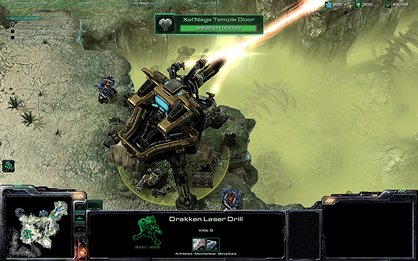Peeling back the final layer of StarCraft II
Blizzard’s potential RTS masterpiece nears its unleash date
In addition to the story missions, Blizzard has implemented a series of Challenges to further test the skills of players. These span all three races, making them perfect for honing one’s skills before throwing down a gauntlet on Battle.net. The few on show required a limited combination of classes to efficiently withstand increasingly difficult waves of enemies. This setup successfully fosters a more intimate understanding of individual units and could lead to tighter games online and off. Each Challenge can be completed with a Bronze, Silver, or Gold medal, and tie into StarCraft II’s achievement system, which touts hundreds of objectives.

The single-player achievements focus on completing the optional objectives in each level, usually on normal or higher difficulty levels. It isn’t an original set of achievements, but it should keep devotees busy while Blizzard prepares the Zerg-focussed Heart of the Swarm for release.
If achievements aren’t your thing or you use your ungodly clicks-per-minute to master them in the first week, the Galaxy Map Editor’s possibilities and StarCraft’s community will help round out an undeniably exhaustive package.
“The stuff I expect to see from custom games is going to be crazy,” says Sigaty, “The guys on the team made The Lost Viking arcade [a minigame in the Battleship Hyperion’s cantina] in two weeks. It’s a top-down shooter, like Raiden or 1942, and it’s absolutely crazy. And it’s all done in StarCraft II’s engine.”
Tucked away in the current build were a handful of Protoss missions which Blizzard was still reluctant to talk about. Although there are 29 missions in Wings’ campaign, five don’t involve Jim Raynor and his crew. After returning from a mission a third of the way through the game, a meeting between Raynor and Zeratul aboard the Hyperion occurs. Upon examining a device Zeratul has with him, the player is sucked into the Dark Templar’s memories. These side-missions aren’t afterthoughts - they start with a five-minute sequence where Kerrigan makes her return. These are a great influx of variety from the usual Terran missions, and a pat on the head for Protoss fans eagerly awaiting Legacy of the Void, the third part of StarCraft II.

But playing the Protoss isn’t the only way that Blizzard has involved them in a single-player campaign. Blizzard has revealed the game’s research system, which will have a drastic impact on your gameplay.
Each mission has a number of optional objectives which are revealed at preset times. If it’s your first time through a mission, you'll have to manage your assets efficiently to compensate for these surprises. Or you could just stay the course and not destroy the extra enemy bases or rescue stranded Terrans, but this inaction costs the ever-precious research points earned by completing each bonus objective. After youhave at least five Zerg or Protoss research points it’s time to start climbing a research tree. Each has two options at each interval (five, 10, 15, 20, and 25 points), but only one can be had, as it locks out its counterpart.
Sign up to the GamesRadar+ Newsletter
Weekly digests, tales from the communities you love, and more
Research Options
Choose your path wisely; there is no turning back...

Protoss Research
Tech Reactor: Combines the functionality of a Tech Lab and a Reactor in a single add-on.
Orbital Strike: Barracks units now arrive by drop pods. These land at the Barracks’ rally point.
Raven: Support unit that can detect cloaked and burrowed enemy units.
Science Vessel: Support unit that sees cloaked and burrowed enemy units.
Automated Refinery: No longer requires SCVs to harvest.
Command Center Reactor: Lets two SCVs to be trained simultaneously.
Orbital Depots: Supply depots can be built instantaneously.
Micro-Filtering: Refineries and Automated Refineries produce Vespene Gas (one of the two main resources) 25% faster.
Ultra-Capacitors: Weapon upgrades in the Armory and Engineering Bay increase attack speed by 5%, in addition to increasing damage.
Vanadium Plating: Armor upgrades in the Armory and Engineering Bay increase health by 5%, in addition to increasing armor.
Zerg Research
Hive Mind: Emulator Structure that can permanently mind control Zerg units.
Psi Disruptor: Defensive structure that slows all nearby Zerg units.
Cellular Reactor: Specialist units gain +100 starting energy and +100 maximum energy.
Regenerative Steel: Ships and vehicles slowly regenerate health.
Predator: Anti-infantry specialist with a powerful area attack.
Hercules: Massive transport that can deploy its cargo almost instantly.
Planetary Fortress: Command centers can be outfitted with the Twin Ibiks Cannon.
Perdition Turret: Flame turret that conceals itself when out of combat.
Shrike Turret: Outfits all bunkers with an automated turret.
Fortified Bunker: Bunkers gain +150 health.
“The Terrans are very clever and not at all above stealing what they can’t invent,” says lead designer Dustin Browder. “But unlike tech purchases where, by the end of the game, you can buy just about everything you want in the armory, here you’re only going to get half the things on any playthrough. We’ve worked really hard to make these some tough choices.”


